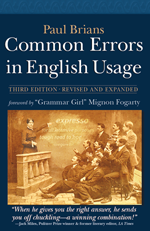The Chicago Manual of Style contains a huge chart listing various sorts of phrases that are or are not to be hyphenated. Consult such a reference source for a thorough-going account of this matter, but you may be able to get by with a few basic rules. An adverb/adjective combination in which the adverb ends in “-LY” is never hyphenated: “His necktie reflected his generally grotesque taste.”
Other sorts of adverbs are followed by a hyphen when combined with an adjective: “His long-suffering wife finally snapped and fed it through the office shredder.” The point here is that “long” modifies “suffering,” not “wife.” When both words modify the same noun, they are not hyphenated. A “light-green suitcase” is pale in color, but a “light green suitcase” is not heavy. In the latter example “light” and “green” both modify “suitcase,” so no hyphen is used.
Adjectives combined with nouns having an “-ED” suffix are hyphenated: “Frank was a hot-headed cop.”
Hyphenate ages when they are adjective phrases involving a unit of measurement: “Her ten-year-old car is beginning to give her trouble.” A girl can be a “ten-year-old” (“child” is implied). But there are no hyphens in such an adjectival phrase as “Her car is ten years old.” In fact, hyphens are generally omitted when such phrases follow the noun they modify except in phrases involving “all” or “self” such as “all-knowing” or “self-confident.”
Fractions are almost always hyphenated when they are adjectives: “He is one-quarter Irish and three-quarters Nigerian.” But when the numerator is already hyphenated, the fraction itself is not, as in “ninety-nine and forty-four one hundredths.” Fractions treated as nouns are not hyphenated: “He ate one quarter of the turkey.”
A phrase composed of a noun and a present participle (“-ing” word) must be hyphenated: “The antenna had been climbed by thrill-seeking teenagers who didn’t realize the top of it was electrified.”
These are the main cases in which people are prone to misuse hyphens. If you can master them, you will have eliminated the vast majority of such mistakes in your writing. Some styles call for space around dashes (a practice of which I strongly disapprove), but it is never proper to surround hyphens with spaces, though in the following sort of pattern you may need to follow a hyphen with a space: “Stacy’s pre- and post-haircut moods.”
BUY THE BOOK!
